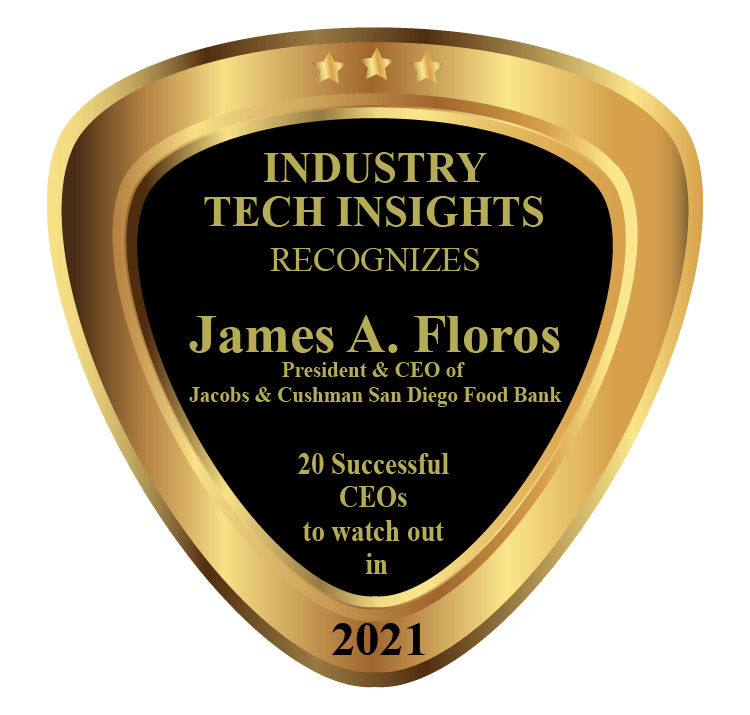
- July 14, 2025 2:04 pm
- California

James A. Floros
President & CEO
One of the things that set James A. Floros, President & CEO, Jacobs & Cushman San Diego Food Bank aside from other nonprofit CEOs is that he has always run a nonprofit like a business. “The efficiency and effectiveness that is required in the for-profit sector is even more important in the nonprofit sector because you are doing more with less, with less staff and less resources,” he explains. “Three to four weeks into the pandemic, I realized how well our organization was doing and I realized it was because of the work we had done in building an organization based on excellence.” They have an outstanding relationship with their donors, with media, elected officials, have top-notch financials, with 94 cents of every dollar going directly to our programs and services, and an amazing culture among the staff and volunteers.
Founded in 1977, the San Diego Food Bank was an organization that only prearranged food drives and food distributions around the holidays. In years after that, the organization realized that food insecurity was a yearlong problem and challenge, and so they began working toward building an organization that would serve the community throughout the year. Food insecurity was still something that many did not realize was a major drain in society. As food banks have grown and become more sophisticated, and links between food insecurity leading to poor academic performance and poor health outcomes became known, food banks then became an essential part of any community’s ability to work to end the cycle of poverty.
“There is a misconception people have about who is served by a food bank. Generally, people think food banks are solely feeding the homeless or those on government assistance. Nothing can be further from the truth,” says James. “Our service population is the working poor, seniors on fixed incomes, children living in poverty and very surprisingly low-income active-duty military families. People all around us are food insecure.” He explains, “people all around us are not reaching their full potential because they are not getting enough nutritious food. If people do not have access to nutritious food, they are more likely to repeat and be stuck in the cycle of poverty.”
A few strengths built into the organization are to be adaptable, know when to pivot, and find a way to overcome any challenge. That was already in their DNA before the pandemic, but that has served them so well throughout these challenging times. “We have seen new problems rise and we have been very quick to change course as needed. We are entering Phase 4 of our COVID response, which means there were three phases beforehand that are perfect examples of how we successfully adapted, pivoted and overcame these unprecedented times,” says James.
The San Diego Food Bank and their North County Food Bank chapter are supply chains at their very best. While they do not prepare meals, that is something that their nonprofit partners would do, what they are doing is distributing essential food items to those that come to distributions. “We do that through 200 direct distributions that we directly oversee. There are over 200 of those each month throughout the county plus, and perhaps one of the best aspects of the San Diego Food Bank and many people do not know this, we have partnerships with more than 500 nonprofits throughout the San Diego region,” explains James. “Any nonprofit that has a feeding program in our county, more likely than not, gets the majority of their food from us. This makes us one of the most grassroots nonprofits in San Diego County.” Their partnerships—an integral part of their success—range from well-known agencies like Catholic Charities and the Salvation Army to smaller church pantries.
San Diego Food Bank’s mission is to provide nutritious food to those in need, so their focus was that and not on becoming an environmentally sensitive organization. However, they discovered that if they were more environmentally conscious, they could save more money, which meant San Diego Food Bank could provide more food to people in need. “We began with 1,400 solar panels, which saves us $120,000 a year, which is the equivalent to about 600,000 meals. We worked with San Diego Gas & Electric for our climate control and lighting,” says James. “Installing phase change material in our freezers, which allows us to turn our compressors off at 7 p.m. at night and not turn it on until the next morning, saves energy, and saves us money.” Their Composting and Recycling Center features a “Turbo Separator.” This machine helps them separate expired food products from their packaging, and the packaging is then recycled, and the food waste is turned into compost. “We were the first food bank in the world to receive LEED v4 Gold Status. And in 2020, we received the City of San Diego’s Business Waste Reduction and Recycling Award. We consider ourselves a zero-waste facility and last year we diverted over 1 million pounds from the landfill,” he adds.
The San Diego Food Bank was feeding 350,000 people before the pandemic; since then, they have almost doubled that amount and are now feeding about 600,000 people a month. This number includes the regular service population that they served before the pandemic, many of them seniors. “We have also made it easier for people to receive food with client dignity. We have invested in what we call “Capacity Grants” to our nonprofit’s partners, which is strengthening their ability to meet the surge in demand, helping them build their resources with pallet jacks, refrigerators, trucks and more,” adds James. “By supporting our partner agencies become more effective, it helps us meet the increased demand amongst our service population. We want to focus on being more than just a food bank; we want to focus on being a nutrition bank.” According to James, “Most notably the Food 4 Kids Backpack program, the feedback we are getting from schools is incredible. Students do not have to worry about where their next meal will come from and can focus on school. We see less absenteeism and students’ grades have improved since being on the program.”

“We want to focus on being more than just a food bank; we want to focus on being a nutrition bank.”